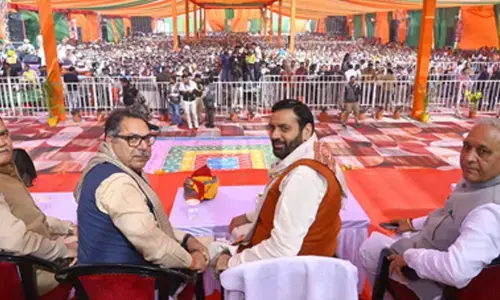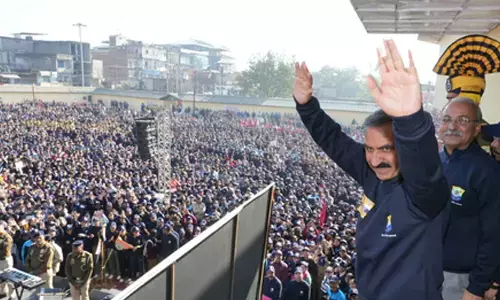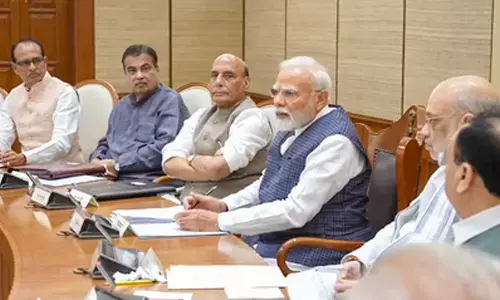What lies at root of economic mess?

Perhaps, no other Prime Minister faced the ignominy that Manmohan Singh did in the wake of his address to the nation on Independence Day. Dr Singh no longer resembles his earlier confident self. And, of course, there are reasons. That his self-appointed challenger Narendra Modi looked even worse the way he took on the Prime Minister, in hurling invectives rather than any substantial critique is, of course, a different proposition altogether.
That his self-appointed challenger Narendra Modi looked even worse the way he took on the Prime Minister, in hurling invectives rather than any substantial critique is, of course, a different proposition altogether
 Perhaps, no other Prime Minister faced the ignominy that Manmohan Singh did in the wake of his address to the nation on Independence Day. Dr Singh no longer resembles his earlier confident self. And, of course, there are reasons. That his self-appointed challenger Narendra Modi looked even worse the way he took on the Prime Minister, in hurling invectives rather than any substantial critique is, of course, a different proposition altogether.
Perhaps, no other Prime Minister faced the ignominy that Manmohan Singh did in the wake of his address to the nation on Independence Day. Dr Singh no longer resembles his earlier confident self. And, of course, there are reasons. That his self-appointed challenger Narendra Modi looked even worse the way he took on the Prime Minister, in hurling invectives rather than any substantial critique is, of course, a different proposition altogether.
The Prime Minister is now increasingly becoming subject of scathing cartoons; a cartoon depicts him in a crestfallen mood in his Prime Ministerial chair with an insignia captioned, ‘the buck does not stop here’. The Prime Minister’s image-makers have, over the years, made up for his lack of experience in mass politics and inspirational qualities with his acumen in matters relating to economy. In particular, his exploits as Finance Minister in the Narasimha Rao government is emphasized. He is credited with having taken Indian economy away from the precipice in early 1990s.
At this point in time, when economy is certainly in the throes of severe slowdown and threats confronting from all corners, obvious comparisons are being made between then and now. And, this makes him a tragic-comic figure. To be fair to him, however, an objective comparison would be in order. In 1991-92, embarking on the reform process, he had urged ‘there is no time to lose’. Current Account Deficit (CAD) at that point in time was 2.5 per cent of the GDP. Today, it stands at 4.8 per cent. Debt service burden was 21 per cent of current account receipts. Now it stands at 35.09 per cent. Foreign exchange reserves could ensure imports for barely six weeks; now it is slightly better (five and a half months) but much lower than many other emerging economies and the lowest among BRIC countries.
In 1991, he had observed in his budget speech: “The major worrisome feature of the inflation in 1990-91 was that it was concentrating in essential commodities”. Aam aadmi would be a better judge of the reality today. Never before has the inflation driven by prices of essential commodities, particularly food, been as consistent as in the last four years.
What did he do then? He had embarked on economic reforms with an export-led strategy. In order to provide exports a boost, he had opted for a two-stage devaluation of the rupee by over 20 per cent. This was to further depreciation that rupee was undergoing in the closing years of the 1980s. But can the current free fall of the rupee which threatens a huge increase in the oil import bill compare with the course he had chosen consciously a little over two decades back?
By all counts, the economy is in a mess. GDP growth will be substantially less than 7 per cent in the last fiscal. Manufacturing growth is less than 3 per cent compared to nearly 9 per cent last year. Inflation this year has been 10.4 per cent in April from 9.5 per cent in March, 8.8 per cent in February and 7.7 per cent in January. Would the Prime Minister term this coexisting near stagnation of the economy and runaway inflation as stagflation? So, notwithstanding his sadness, he can hardly complain about the comparison.
Today, the situation is bad enough for his otherwise vehement Finance Minister to be admitting that the economy is in a bad shape. Of course, this was while he was complaining about ‘pessimism’ on the falling rupee and was trying to reassure that there is no cause for unnecessary alarm.
But unraveling the genesis of the crisis, one can only get back to the fundamental presumptions which have powered the reform process all along; in fact, such was the blind faith that it had come to assume threatening proportions much in the vein of `shock and awe’ against critics. The centerpiece was growth, regardless of the manner in which it was achieved and the impact it had on different sections of society. That this growth pattern was giving rise to unsustainable levels of inequality, unemployment and poverty was dismissed with contempt.
In the recent debate between Jagdish Bhagwati and Amartya Sen, we had been witness to arrogance of this single-minded obsession with growth at all costs. Even a mild suggestion by Professor Sen to the effect that without adequate levels of investment in the social sector, particularly in primary health and primary education, the benefits of growth cannot accrue to a large section of the people was dubbed as anti-growth. Not that Professor Sen is a radical, but the silence of the Prime Minister and his boys, mandarins of the economic establishment, was eloquent; because, even if unstated, there was a clear preference for Bhagwati’s shrill claims.
That this dogma and the belief that the government’s only concern ought to be facilitating investment; and it is investment alone by foreign and domestic corporates that can deliver growth has hamstrung our economy. In fact, the export potential of India today stands greatly jeopardized by conditions of global economy. In this situation, presumption that our CAD would continue to be financed by FIIs as in boom years was completely misplaced.
And, today, it is clear that unlike the early 1990s, the bulk of CAD is on account of reckless External Commercial Borrowing (ECB) by private corporates. The comparison is stark. In March 1991, out of India’s total external debt of $83.80 billion, $48.59 or 58 per cent was on government account. According to the latest RBI status report, in March 2013 India’s external debt stood at $390.05 billion. But unlike 1991, government’s account is just $ 81.65 billion, a little less than 21 per cent. The rest is non-government debt.
Further, a recent Credit Suisse Research Report states that total outstanding borrowings of just 10 large corporate groups have clocked a six-fold increase in the last six years to over $ 100 billion. No doubt, the government’s policy of easing conditions for ECBs in quest of growth has led to this precarious situation.
India has an advantage. And, the course adopted by China, evidently with a great degree of success, underlines this. The huge domestic population, if adequately empowered and their purchasing power shored up, this could provide adequate ground for sustaining growth. Else, all tax waivers and other incentives would end up in financing investments in unproductive assets.














